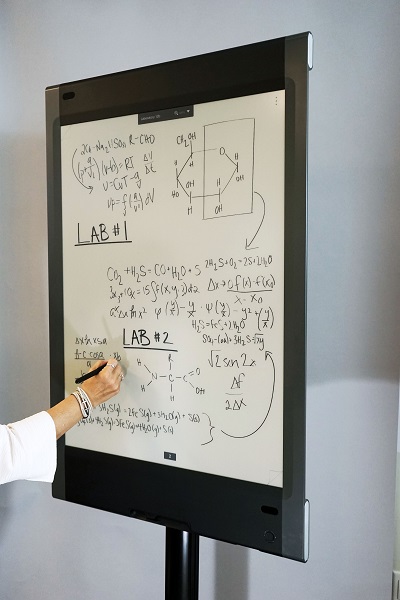I saw this product last year at InfoComm and was dutifully impressed, but did not write an article about it, because my editor beat me to the punch. Fast forward. The product returned to InfoComm 2017 with a new name (Quilla), new partners, and renewed purpose. And I still like it.

Yet I write about display technologies for the education market—and this product carries the flag for business use cases. So how does a promising technology like Quilla successfully reach the education vertical? That’s the eccentric and inverted subject of this article.
 Quilla from QuirkLogic and E Ink
Quilla from QuirkLogic and E Ink
A Little about Quilla
No strangers to the education market, the founders of QuirkLogic previously led another company, Elluminate, which developed products for the delivery of live collaboration and distance learning over the web for the education market. This previous offering, a Software as a Service (SaaS) product, was used by “millions of users from over 170 countries.” A new joint effort of QuirkLogic and E Ink, created “the world’s largest ePaper display (42” diagonal)”, which is a unique feature in Quilla. “More than a digital writing device”, Quilla is described as a low-power-consuming display that “enables teams with multiple locations or remote workers to create and collaborate” using digital ink.
Segmentation by Location
When selling in the education vertical, a consumer device company cannot only think about typical ‘classroom’ marketshare. There may be other opportunities that make more sense. The CEO and co-founder of QuirkLogic, Nashir Samanani, is definitely tuned into this challenge. He outlines: “We know that whiteboards are used in meeting rooms; that staff have to collaborate with users on other campuses in different locations; and that student collaboration spaces in libraries and shared areas [are common].” This is knowledgeable thinking. Quilla isn’t likely to dethrone large signage displays from university and K-12 classroom walls. Their most advantaged opening is to try to sell into the other situational segments, such as conference rooms, meeting rooms, seminar rooms, team rooms, shared collaboration spaces, and what we call in education dedicated “smart rooms or “smart conferencing rooms.” There is also huge potential to reach many of the online synchronous “distance learning” classrooms that pepper rural educational markets. The sales opportunities are ample in these spaces, although the segments are obviously smaller.
Of Slogans, Taglines and Battle Cries
Selling in the education vertical also requires the right ‘lingo’, the ability to connect the product with the acute pain points of the customer. Currently, Quilla promotes the notion of “a real-time ideation solution” aimed at the enterprise customer. I’m not sure this tagline will appeal to the education market, but their notion of “digital ink” will indeed spur some curiosity. (The digital ink metaphor speaks well to the flexibility, the transportability of data, and the sharing of ideas and resources that are made possible through this product.)
According to Samanani, the use of Quilla provides educators with the same value experienced by corporate users: “Quilla’s writing feels familiar (like paper and pen), content is automatically saved as you write, and workbooks can be shared to connect with others for real-time content creation”. Samanani gleefully underscores: “With Quilla, whiteboard photos stored on personal phones and lost notes will become a thing of the past”. Reaching the ear of the fickle education vertical requires a bit of agility, too. The collaboration aspects of this product may provide the best footing. And Quilla’s low-power requirements will be a plus. Messaging is important.
Quilla: Digital ink that is collaborative
Avoiding Pricing Failures
Any firm hoping to successfully conquer the education vertical must also demonstrate hyperawareness of the importance of pricing and the pitfalls of “pricing failure.” It remains obvious that education markets are more sensitive to the issues of price, warranty, total cost of ownership and training than other industries. And the opposite of “pricing success”, called “pricing failure”, is a challenge to be taken seriously. “Pricing failure” occurs often when there isn’t a direct and clear correlation between an item’s cost and its perceived value/quality in a specific vertical, like the education market. Whenever “pricing failure” occurs, it is noticeable by the gut-wrenching reactions seen exhibited by educational buyers.
Samanani is well aware of these challenges as well, arguing: “We understand that selling to education is different than selling to other markets due to their price sensitivity and buying patterns. Our previous company had thousands of education customers and therefore we are very much attuned to education pricing”. Since QuirkLogic’s founders have a lot of experience in the education market, they have commenced discussions with their former customers at various educational institutions to get feedback before finalizing prices. He thoughtfully reflects: “While we have not yet finalized our pricing for education, we will be responding to education as a sector with its own requirements”.
Some Concluding Thoughts
Although Quilla’s impressive technology will not fundamentally replace large room displays, I am still sold on the possibilities for this technology in the education market. Samanani predicts: “As we look to the future, for Quilla, we will consider integrating Quilla to other learning technologies such as learning management systems and lecture capture solutions”. He continues: “We will also look at use cases in the classroom and tailor the feature set in Quilla for classroom instruction.” With the right place to go, the right messaging, and the right price—anything is possible. –Len Scrogan

